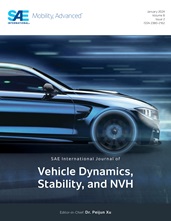Handling and ride comfort optimization are key vehicle design challenges. To
analyze vehicle performance and investigate the dynamics of the vehicle and its
subcomponents, we rely heavily on robust experimental data.
The current article proposes an outdoor cleat test methodology to characterize
tire dynamics. Compared to indoor procedures, it provides an effective tire
operating environment, including the suspensions and the vehicle chassis motion
influence. In addition, it overcomes the main limitation of existing outdoor
procedures, the need for dedicated cleat test tracks, by using a set of
removable cleats of different sizes.
A passenger vehicle was equipped with sensors including an inertial measurement
unit, a noncontact vehicle speed sensor, and a wheel force transducer, providing
a setup suitable to perform both a handling test routine and the designed cleat
procedure, aimed at ride testing and analysis.
Thus, the outdoor cleat test data were compared with indoor test measurements
through objective metrics to define the influence of the operating conditions on
the measured response. The identification of coherent trends between such two
cleat test procedures, together with the repeatability of the outdoor campaign's
results, consisted of a first validation of the designed experimental
methodology.
This achievement, coupled with the possibility of observing other relevant
suspension dynamics phenomena, allows the design of a unique experimental
campaign to collect data suitable for the validation of tire–vehicle models
employed in tire and vehicle simulations design or onboard driving simulators,
both in handling and ride comfort scenarios.
